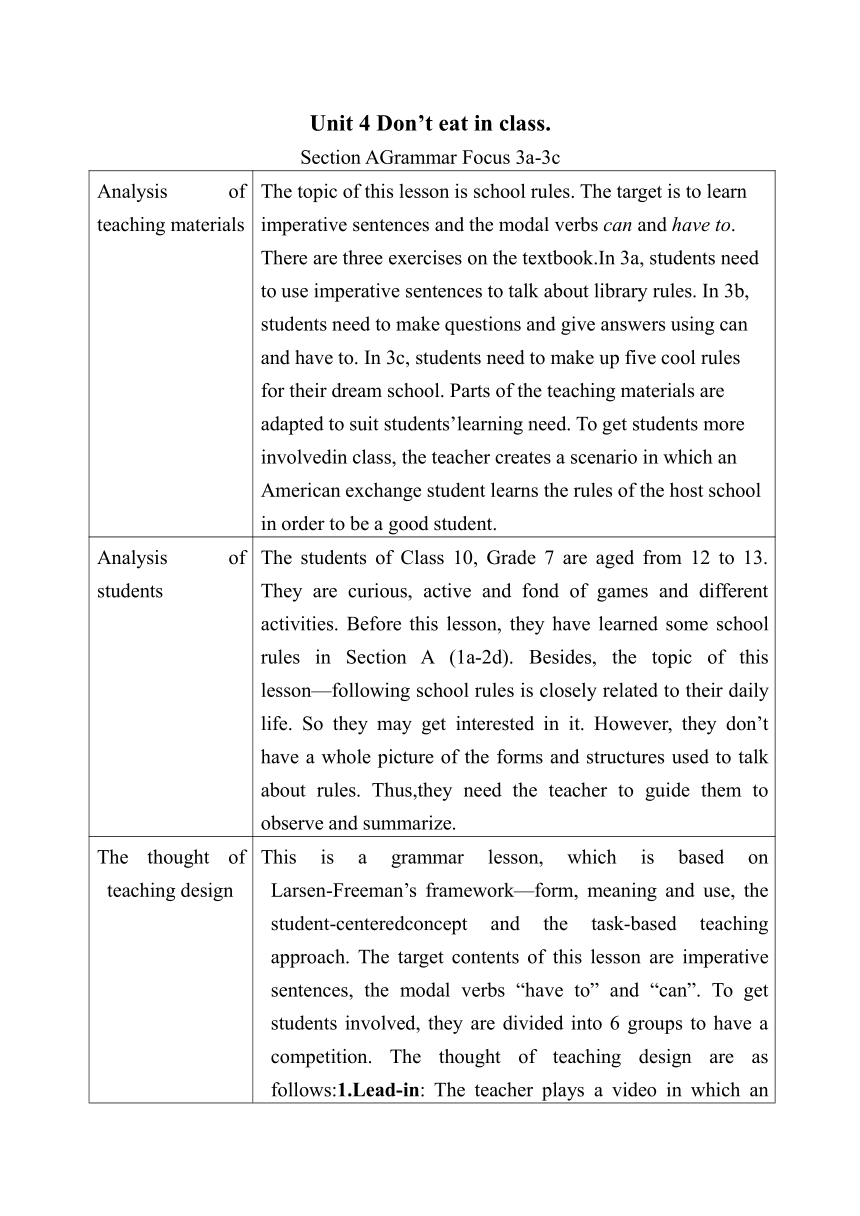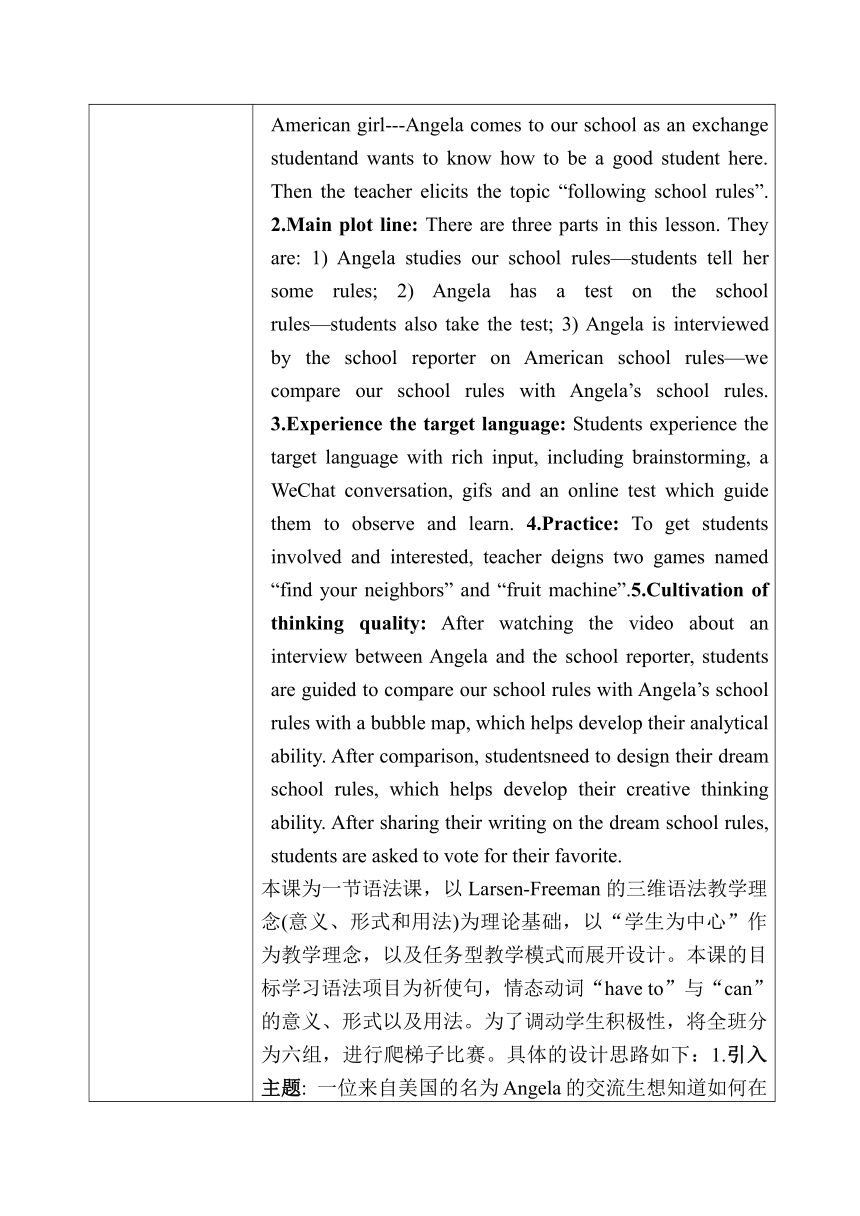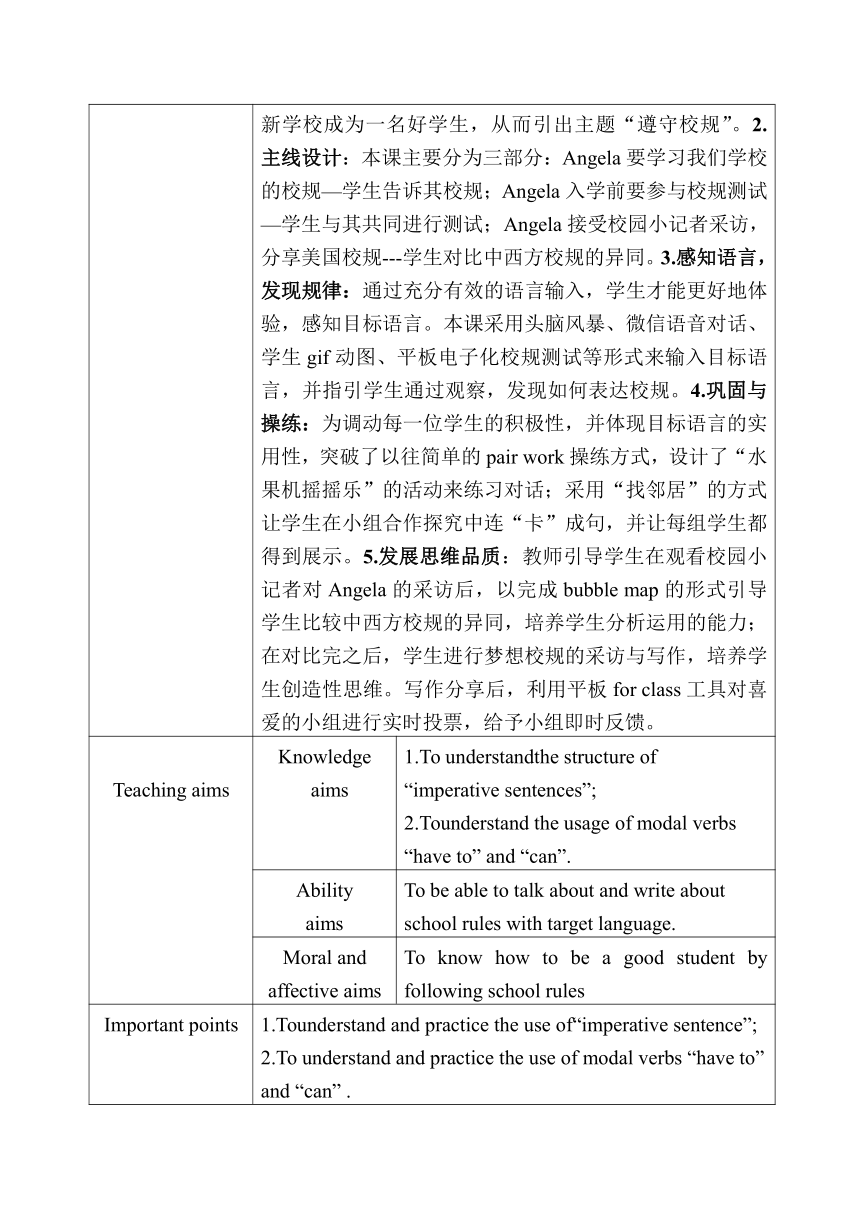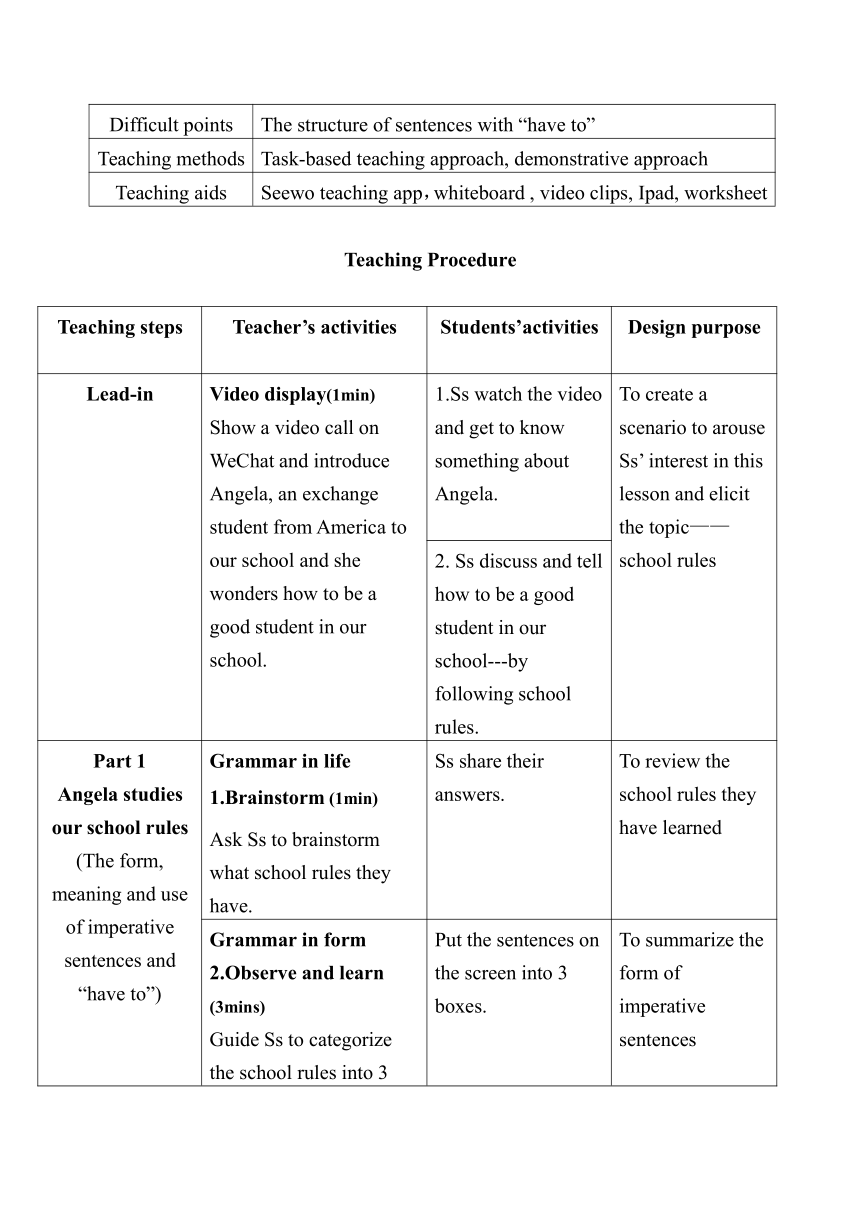Unit 4 Don't eat in class-Section A 2d—3c 教案(表格式)
文档属性
| 名称 | Unit 4 Don't eat in class-Section A 2d—3c 教案(表格式) |

|
|
| 格式 | doc | ||
| 文件大小 | 219.0KB | ||
| 资源类型 | 教案 | ||
| 版本资源 | 人教新目标(Go for it)版 | ||
| 科目 | 英语 | ||
| 更新时间 | 2022-03-22 09:48:49 | ||
图片预览




文档简介
Unit 4 Don’t eat in class.
Section AGrammar Focus 3a-3c
Analysis of teaching materials The topic of this lesson is school rules. The target is to learn imperative sentences and the modal verbs can and have to. There are three exercises on the textbook.In 3a, students need to use imperative sentences to talk about library rules. In 3b, students need to make questions and give answers using can and have to. In 3c, students need to make up five cool rules for their dream school. Parts of the teaching materials are adapted to suit students’learning need. To get students more involvedin class, the teacher creates a scenario in which an American exchange student learns the rules of the host school in order to be a good student.
Analysis of students The students of Class 10, Grade 7 are aged from 12 to 13. They are curious, active and fond of games and different activities. Before this lesson, they have learned some school rules in Section A (1a-2d). Besides, the topic of this lesson—following school rules is closely related to their daily life. So they may get interested in it. However, they don’t have a whole picture of the forms and structures used to talk about rules. Thus,they need the teacher to guide them to observe and summarize.
The thought of teaching design This is a grammar lesson, which is based on Larsen-Freeman’s framework—form, meaning and use, the student-centeredconcept and the task-based teaching approach. The target contents of this lesson are imperative sentences, the modal verbs “have to” and “can”. To get students involved, they are divided into 6 groups to have a competition. The thought of teaching design are as follows:1.Lead-in: The teacher plays a video in which an American girl---Angela comes to our school as an exchange studentand wants to know how to be a good student here. Then the teacher elicits the topic “following school rules”. 2.Main plot line: There are three parts in this lesson. They are: 1) Angela studies our school rules—students tell her some rules; 2) Angela has a test on the school rules—students also take the test; 3) Angela is interviewed by the school reporter on American school rules—we compare our school rules with Angela’s school rules. 3.Experience the target language: Students experience the target language with rich input, including brainstorming, a WeChat conversation, gifs and an online test which guide them to observe and learn. 4.Practice: To get students involved and interested, teacher deigns two games named “find your neighbors” and “fruit machine”.5.Cultivation of thinking quality: After watching the video about an interview between Angela and the school reporter, students are guided to compare our school rules with Angela’s school rules with a bubble map, which helps develop their analytical ability. After comparison, studentsneed to design their dream school rules, which helps develop their creative thinking ability. After sharing their writing on the dream school rules, students are asked to vote for their favorite.本课为一节语法课,以Larsen-Freeman的三维语法教学理念(意义、形式和用法)为理论基础,以“学生为中心”作为教学理念,以及任务型教学模式而展开设计。本课的目标学习语法项目为祈使句,情态动词“have to”与“can”的意义、形式以及用法。为了调动学生积极性,将全班分为六组,进行爬梯子比赛。具体的设计思路如下:1.引入主题: 一位来自美国的名为Angela的交流生想知道如何在新学校成为一名好学生,从而引出主题“遵守校规”。2.主线设计:本课主要分为三部分:Angela要学习我们学校的校规—学生告诉其校规;Angela入学前要参与校规测试—学生与其共同进行测试;Angela接受校园小记者采访,分享美国校规---学生对比中西方校规的异同。3.感知语言,发现规律:通过充分有效的语言输入,学生才能更好地体验,感知目标语言。本课采用头脑风暴、微信语音对话、学生gif动图、平板电子化校规测试等形式来输入目标语言,并指引学生通过观察,发现如何表达校规。4.巩固与操练:为调动每一位学生的积极性,并体现目标语言的实用性,突破了以往简单的pair work操练方式,设计了“水果机摇摇乐”的活动来练习对话;采用“找邻居”的方式让学生在小组合作探究中连“卡”成句,并让每组学生都得到展示。5.发展思维品质:教师引导学生在观看校园小记者对Angela的采访后,以完成bubble map的形式引导学生比较中西方校规的异同,培养学生分析运用的能力;在对比完之后,学生进行梦想校规的采访与写作,培养学生创造性思维。写作分享后,利用平板for class工具对喜爱的小组进行实时投票,给予小组即时反馈。
Teaching aims Knowledge aims 1.To understandthe structure of “imperative sentences”;2.Tounderstand the usage of modal verbs “have to” and “can”.
Ability aims To be able to talk about and write about school rules with target language.
Moral and affective aims To know how to be a good student by following school rules
Important points 1.Tounderstand and practice the use of“imperative sentence”;2.To understand and practice the use of modal verbs “have to” and “can” .
Difficult points The structure of sentences with “have to”
Teaching methods Task-based teaching approach, demonstrative approach
Teaching aids Seewo teaching app,whiteboard , video clips, Ipad, worksheet
Teaching Procedure
Teaching steps Teacher’s activities Students’activities Design purpose
Lead-in Video display(1min)Show a video call on WeChat and introduce Angela, an exchange student from America to our school and she wonders how to be a good student in our school. 1.Ss watch the video and get to know something about Angela. To create a scenario to arouse Ss’ interest in this lesson and elicit the topic——school rules
2. Ss discuss and tell how to be a good student in our school---by following school rules.
Part 1Angela studies our school rules(The form, meaning and use of imperative sentences and “have to”) Grammar in life1.Brainstorm (1min)Ask Ss to brainstorm what school rules they have. Ss share their answers. To review the school rules they have learned
Grammar in form 2.Observe and learn(3mins)Guide Ss to categorize the school rules into 3 types, type Be,type Do and type Don’t. Put the sentences on the screen into 3 boxes. To summarize the form of imperative sentences
3.Grammar in use1)Write the library rules(2mins)Have Ss tell Angela our library rules by finishing 3a on Page 21.2) Competition(4mins)Have Ss work in a group and take turns to say imperative sentences with given three types. 1) Finish Part 1 on the worksheet. (3a on Page 21)2) Ss take turns to say sentences within 1 minute. Each student says one sentence each time. The group with the most sentences is the winner. To consolidate the use of imperative sentences used to talk about rules
Grammar in life4.Listening(2mins)Tell Ss that Angela got a WeChat message from her dad. Then ask Ss to listen to their conversation and fill in the blanks. Ss listen to the conversation and fill in the blanks. To elicit sentences with “have to”
5. Look and say(1min)Get Ss look at the picture and ask them some questions:1) What do you have to do 2) Do you have to do it every school day Ss look at the picture and answer the questions together. To get Ssto know how to use “have to”
Grammar in form6. Observe and learn(2mins)Guide Ss to observe the sentences with “have to” and find out the structures of affirmative and negative sentences and general questions. Observe the given sentences and the color words first. Then find out the sentence structures and finish the worksheet. To help Ss summarize the structure of sentences with “have to”
Grammar in use7.Game—find your neighbors(4mins)Give each group some cards and ask them to put the cards into right order to make a correct sentence. Ss work in group to put the cards into right order. To consolidate the learning of the structure with “have to”
Part 2Angela has a test about our school rules.(The form, meaning and use of modal verbs “can”) 1.Test on school rules(2mins)Have Ss take out their Ipads and finish the test of our school rules for Angela.e.g. Can we listen to music in class A. Yes, I can.B. No, I can’t. Ss take the test on their Ipads. To have Ss get to know the meaning and usage of “can”
2.Observe and learn(2mins)Ask Ss to observe the sentences with “can” or to find out the usage of it. Observe the given sentences and the words in red first. Then find out some rules about “can” To help Ss summarize the structure of sentences with “can”
3. Grammar in use --pair work(2mins)Get Ss to work in pairs to make conversations with “can” on the fruit machine. The teacher gives a model first. Ss make a conversation with the given words in pairs. To consolidate the acquisition of the key structures with “can”
Part 3Angela has an interview. 1.Comparison(3mins)1) Play a video and ask Ss to compare Angela’s school rules and our school rules;2) Guide Ss to finish the mind map. Watch the video and finish the mind map. To enhanceSs’ listeningskillsand to develop their thinking ability through comparison
2.Group work: interview(4mins)Ask Ss to work in groups to role-play an interview to talk about their dream school rules. Role-play and talk about their dream school rules. To develop their speaking ability and creative thinking ability
3.Writing(5mins)1) Have Ss to write their dream school rules on the worksheet.2) Share Ss’ writings. 1) Write their dream school rules on their worksheet.2) Present the writing. To consolidate the use of the target sentence structures
4.Cast a vote(1min)Have Ss vote for their favorite dream school rules. Take out the Ipad and vote for their favorite group. To give feedback to the two groups which present their dream school rules
Summary 1) Summarize what we have learned in this lesson.(30’)
2) Today’s sentence: Rules help us to be good students.(30’)
Homework Design a poster and write down your own dream school rules
Blackboard design
Section AGrammar Focus 3a-3c
Analysis of teaching materials The topic of this lesson is school rules. The target is to learn imperative sentences and the modal verbs can and have to. There are three exercises on the textbook.In 3a, students need to use imperative sentences to talk about library rules. In 3b, students need to make questions and give answers using can and have to. In 3c, students need to make up five cool rules for their dream school. Parts of the teaching materials are adapted to suit students’learning need. To get students more involvedin class, the teacher creates a scenario in which an American exchange student learns the rules of the host school in order to be a good student.
Analysis of students The students of Class 10, Grade 7 are aged from 12 to 13. They are curious, active and fond of games and different activities. Before this lesson, they have learned some school rules in Section A (1a-2d). Besides, the topic of this lesson—following school rules is closely related to their daily life. So they may get interested in it. However, they don’t have a whole picture of the forms and structures used to talk about rules. Thus,they need the teacher to guide them to observe and summarize.
The thought of teaching design This is a grammar lesson, which is based on Larsen-Freeman’s framework—form, meaning and use, the student-centeredconcept and the task-based teaching approach. The target contents of this lesson are imperative sentences, the modal verbs “have to” and “can”. To get students involved, they are divided into 6 groups to have a competition. The thought of teaching design are as follows:1.Lead-in: The teacher plays a video in which an American girl---Angela comes to our school as an exchange studentand wants to know how to be a good student here. Then the teacher elicits the topic “following school rules”. 2.Main plot line: There are three parts in this lesson. They are: 1) Angela studies our school rules—students tell her some rules; 2) Angela has a test on the school rules—students also take the test; 3) Angela is interviewed by the school reporter on American school rules—we compare our school rules with Angela’s school rules. 3.Experience the target language: Students experience the target language with rich input, including brainstorming, a WeChat conversation, gifs and an online test which guide them to observe and learn. 4.Practice: To get students involved and interested, teacher deigns two games named “find your neighbors” and “fruit machine”.5.Cultivation of thinking quality: After watching the video about an interview between Angela and the school reporter, students are guided to compare our school rules with Angela’s school rules with a bubble map, which helps develop their analytical ability. After comparison, studentsneed to design their dream school rules, which helps develop their creative thinking ability. After sharing their writing on the dream school rules, students are asked to vote for their favorite.本课为一节语法课,以Larsen-Freeman的三维语法教学理念(意义、形式和用法)为理论基础,以“学生为中心”作为教学理念,以及任务型教学模式而展开设计。本课的目标学习语法项目为祈使句,情态动词“have to”与“can”的意义、形式以及用法。为了调动学生积极性,将全班分为六组,进行爬梯子比赛。具体的设计思路如下:1.引入主题: 一位来自美国的名为Angela的交流生想知道如何在新学校成为一名好学生,从而引出主题“遵守校规”。2.主线设计:本课主要分为三部分:Angela要学习我们学校的校规—学生告诉其校规;Angela入学前要参与校规测试—学生与其共同进行测试;Angela接受校园小记者采访,分享美国校规---学生对比中西方校规的异同。3.感知语言,发现规律:通过充分有效的语言输入,学生才能更好地体验,感知目标语言。本课采用头脑风暴、微信语音对话、学生gif动图、平板电子化校规测试等形式来输入目标语言,并指引学生通过观察,发现如何表达校规。4.巩固与操练:为调动每一位学生的积极性,并体现目标语言的实用性,突破了以往简单的pair work操练方式,设计了“水果机摇摇乐”的活动来练习对话;采用“找邻居”的方式让学生在小组合作探究中连“卡”成句,并让每组学生都得到展示。5.发展思维品质:教师引导学生在观看校园小记者对Angela的采访后,以完成bubble map的形式引导学生比较中西方校规的异同,培养学生分析运用的能力;在对比完之后,学生进行梦想校规的采访与写作,培养学生创造性思维。写作分享后,利用平板for class工具对喜爱的小组进行实时投票,给予小组即时反馈。
Teaching aims Knowledge aims 1.To understandthe structure of “imperative sentences”;2.Tounderstand the usage of modal verbs “have to” and “can”.
Ability aims To be able to talk about and write about school rules with target language.
Moral and affective aims To know how to be a good student by following school rules
Important points 1.Tounderstand and practice the use of“imperative sentence”;2.To understand and practice the use of modal verbs “have to” and “can” .
Difficult points The structure of sentences with “have to”
Teaching methods Task-based teaching approach, demonstrative approach
Teaching aids Seewo teaching app,whiteboard , video clips, Ipad, worksheet
Teaching Procedure
Teaching steps Teacher’s activities Students’activities Design purpose
Lead-in Video display(1min)Show a video call on WeChat and introduce Angela, an exchange student from America to our school and she wonders how to be a good student in our school. 1.Ss watch the video and get to know something about Angela. To create a scenario to arouse Ss’ interest in this lesson and elicit the topic——school rules
2. Ss discuss and tell how to be a good student in our school---by following school rules.
Part 1Angela studies our school rules(The form, meaning and use of imperative sentences and “have to”) Grammar in life1.Brainstorm (1min)Ask Ss to brainstorm what school rules they have. Ss share their answers. To review the school rules they have learned
Grammar in form 2.Observe and learn(3mins)Guide Ss to categorize the school rules into 3 types, type Be,type Do and type Don’t. Put the sentences on the screen into 3 boxes. To summarize the form of imperative sentences
3.Grammar in use1)Write the library rules(2mins)Have Ss tell Angela our library rules by finishing 3a on Page 21.2) Competition(4mins)Have Ss work in a group and take turns to say imperative sentences with given three types. 1) Finish Part 1 on the worksheet. (3a on Page 21)2) Ss take turns to say sentences within 1 minute. Each student says one sentence each time. The group with the most sentences is the winner. To consolidate the use of imperative sentences used to talk about rules
Grammar in life4.Listening(2mins)Tell Ss that Angela got a WeChat message from her dad. Then ask Ss to listen to their conversation and fill in the blanks. Ss listen to the conversation and fill in the blanks. To elicit sentences with “have to”
5. Look and say(1min)Get Ss look at the picture and ask them some questions:1) What do you have to do 2) Do you have to do it every school day Ss look at the picture and answer the questions together. To get Ssto know how to use “have to”
Grammar in form6. Observe and learn(2mins)Guide Ss to observe the sentences with “have to” and find out the structures of affirmative and negative sentences and general questions. Observe the given sentences and the color words first. Then find out the sentence structures and finish the worksheet. To help Ss summarize the structure of sentences with “have to”
Grammar in use7.Game—find your neighbors(4mins)Give each group some cards and ask them to put the cards into right order to make a correct sentence. Ss work in group to put the cards into right order. To consolidate the learning of the structure with “have to”
Part 2Angela has a test about our school rules.(The form, meaning and use of modal verbs “can”) 1.Test on school rules(2mins)Have Ss take out their Ipads and finish the test of our school rules for Angela.e.g. Can we listen to music in class A. Yes, I can.B. No, I can’t. Ss take the test on their Ipads. To have Ss get to know the meaning and usage of “can”
2.Observe and learn(2mins)Ask Ss to observe the sentences with “can” or to find out the usage of it. Observe the given sentences and the words in red first. Then find out some rules about “can” To help Ss summarize the structure of sentences with “can”
3. Grammar in use --pair work(2mins)Get Ss to work in pairs to make conversations with “can” on the fruit machine. The teacher gives a model first. Ss make a conversation with the given words in pairs. To consolidate the acquisition of the key structures with “can”
Part 3Angela has an interview. 1.Comparison(3mins)1) Play a video and ask Ss to compare Angela’s school rules and our school rules;2) Guide Ss to finish the mind map. Watch the video and finish the mind map. To enhanceSs’ listeningskillsand to develop their thinking ability through comparison
2.Group work: interview(4mins)Ask Ss to work in groups to role-play an interview to talk about their dream school rules. Role-play and talk about their dream school rules. To develop their speaking ability and creative thinking ability
3.Writing(5mins)1) Have Ss to write their dream school rules on the worksheet.2) Share Ss’ writings. 1) Write their dream school rules on their worksheet.2) Present the writing. To consolidate the use of the target sentence structures
4.Cast a vote(1min)Have Ss vote for their favorite dream school rules. Take out the Ipad and vote for their favorite group. To give feedback to the two groups which present their dream school rules
Summary 1) Summarize what we have learned in this lesson.(30’)
2) Today’s sentence: Rules help us to be good students.(30’)
Homework Design a poster and write down your own dream school rules
Blackboard design
同课章节目录
- Unit 1 Can you play the guitar?
- Section A
- Section B
- Unit 2 What time do you go to school?
- Section A
- Section B
- Unit 3 How do you get to school?
- Section A
- Section B
- Unit 4 Don't eat in class.
- Section A
- Section B
- Unit 5 Why do you like pandas?
- Section A
- Section B
- Unit 6 I'm watching TV.
- Section A
- Section B
- Review of Units 1-6
- Unit 7 It's raining!
- Section A
- Section B
- Unit 8 Is there a post office near here?
- Section A
- Section B
- Unit 9 What does he look like?
- Section A
- Section B
- Unit 10 I'd like some noodles.
- Section A
- Section B
- Unit 11 How was your school trip?
- Section A
- Section B
- Unit 12 What did you do last weekend?
- Section A
- Section B
